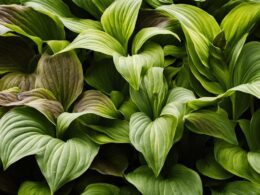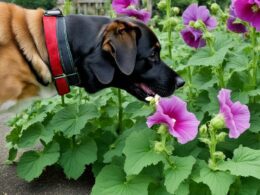Have you ever wondered if your furry friend’s pee could be damaging your lush green lawn? Well, the answer is yes – dog urine can indeed harm your grass. However, it’s not the urine itself that causes the damage, but rather the chemical compounds it contains.
One of the key culprits is a high concentration of nitrogen found in dog urine. When the water in the urine evaporates, it leaves behind a concentrated amount of nitrogen that can be detrimental to your grass. This can result in dead patches and unsightly yellow or brown spots on your once vibrant lawn.
But don’t fret just yet! There are measures you can take to safeguard your lawn and prevent damage caused by dog urine. In this article, we’ll explore why dog pee discolors your grass, whether female dogs cause more damage than male dogs, and how changing your dog’s diet can help mitigate urine-related harm.
Discover simple steps you can take to protect your lawn, including designating a pee spot, choosing resilient grass varieties, and implementing proper lawn maintenance techniques. We’ll also provide you with valuable tips on how to maintain a healthy and beautiful lawn while being a proud dog owner.
Stay tuned to learn more about this common concern and find out how you can keep your lawn looking pristine, even with a four-legged friend in tow. Let’s dive in and uncover the secrets to maintaining a dog-friendly and envy-worthy lawn!
Why Does Dog Pee Discolor Your Grass?
Dog urine contains chemical compounds, including a high concentration of nitrogen. When the water in the urine evaporates, it leaves behind a concentrated amount of nitrogen, which can be harmful to grass. This can lead to brown spots on the grass, with the center appearing brown and the edges remaining green due to the varying concentrations of nitrogen. If you already fertilize your lawn with nitrogen and then your dog pees in one area, it can result in an overdose of nitrogen, potentially killing the grass.
As the image shows, the high concentration of nitrogen in dog urine can cause unsightly brown spots on your otherwise lush green lawn. Understanding why dog pee discolors your grass is the first step towards finding ways to minimize the damage and keep your lawn healthy.
Do Female Dogs Cause More Damage?
It might seem that female dogs cause more damage to grass, but this has more to do with their peeing habits than the chemicals in their urine.
Male dogs tend to lift their leg and disperse their urine, which can result in less concentrated spots and less damage to the grass. Their urine is often distributed over a larger area.
Female dogs, on the other hand, typically squat and pee directly onto the grass, often repeating in the same area. This repeated peeing can lead to a more concentrated spot of urine and increased damage to the grass.
Grass burns caused by dog urine are more likely to occur in areas where female dogs repeatedly pee. The concentrated spot of urine can cause the grass to die, resulting in unsightly yellow or brown patches on your lawn.
To minimize the damage, consider training your female dog to use a designated pee area away from the main lawn. Creating a designated spot with gravel or mulch can help protect your grass by minimizing direct contact with concentrated urine. Regularly watering down the area can also dilute the urine and reduce its impact on the grass.
Can Changing Your Dog’s Diet Help?
Changing your dog’s diet can have a positive impact on reducing the damage caused by their urine. By feeding your dog a raw or homemade diet that is less processed, you can potentially lower the nitrogen content in their urine.
One way to mitigate the effects of nitrogen in urine is by encouraging your dog to drink more water. This helps to dilute their urine, reducing the concentration of nitrogen that can harm your lawn. Make sure to provide fresh, clean water at all times, as hydration is key to minimizing urine damage.
If you’re considering changing your dog’s diet, you can also add water or goat’s milk to their food to increase their water consumption. Additionally, incorporating hydrating fruits into their diet can contribute to their overall water intake.
By making these dietary adjustments, you can potentially reduce the impact of your dog’s urine on your lawn and promote a healthier and happier pet.
What Can You Do to Protect Your Lawn?
There are several steps you can take to protect your lawn from damage caused by dog urine. By implementing these tips, you can maintain a healthy and vibrant lawn for you and your furry friend to enjoy.
1. Pee Spot Designation
Designate a specific spot in your yard for your dog to pee. This will help concentrate the urine damage to one area, protecting the rest of your lawn. You can train your dog to use this designated spot by consistently taking them to that area when it’s time to relieve themselves. With time and consistency, your dog will learn to associate this spot with bathroom breaks.
2. Create a Plant-Free Zone
Consider creating a plant-free zone in your yard, such as a mulch or gravel area, where your dog can do their business. This will provide a barrier between the urine and your grass, preventing damage. Plus, it’s a low-maintenance solution that adds an element of convenience.
3. Choose Resilient Grass Varieties
To combat urine damage, choose resilient grass varieties that can withstand the nitrogen concentration in dog urine. Some excellent options include ryegrass, fescue, and sedges. These varieties are hardy and can help replace or supplement your existing lawn, ensuring it stays green and lush.
4. Wash Down the Area
After your dog pees on your lawn, give the area a good rinse with water. This will help dilute the urine and reduce the concentration of nitrogen. Simply grab the garden hose and spray down the designated spot or any areas where your dog has gone. This simple step can go a long way in minimizing urine damage.
5. Lawn Maintenance Tips
To keep your lawn in optimal condition, practice proper lawn maintenance techniques. Reseed any dead patches caused by urine damage, ensuring that your grass stays thick and healthy. Additionally, adjust your grass length to a slightly longer setting, as longer grass can better withstand urine. Regularly mow, water, and fertilize your lawn following best practices.
By following these tips, you can protect your lawn from dog urine damage and maintain a beautiful outdoor space for everyone to enjoy. Remember, preventive measures and consistent maintenance are key to keeping your grass green and resilient.
How Can Dog Urine Impact Grass and What Can I Do to Prevent It?
Dog urine can have a significant impact on grass, causing brown patches and dead spots in your yard. Preventing dog urine damage can be done by diluting the urine with water immediately after your dog goes, encouraging them to drink more water, and training them to go in designated areas. Additionally, lawn repair techniques such as reseeding and regular watering can help restore the damaged grass.
Conclusion
While dog urine can indeed damage grass, understanding the underlying factors can help you protect your lawn. The high concentration of nitrogen in dog urine is the primary culprit behind brown spots and dead patches. By implementing a few simple strategies, you can minimize the impact of dog urine on your grass.
Firstly, consider changing your dog’s diet to reduce the nitrogen content in their urine. A raw or homemade diet can result in urine with lower nitrogen levels. Additionally, encouraging your dog to drink more water dilutes their urine, lessening the harm to your lawn. Ensuring fresh, clean water is readily available and incorporating hydrating foods can increase water consumption.
Designating a specific pee spot for your dog can also protect your lawn. By training your dog to use a designated area, you limit the damage to a particular section rather than the entire lawn. Creating a plant-free zone, such as gravel or mulch, can further safeguard your grass. Choosing resilient grass varieties and regularly maintaining your lawn, including reseeding dead patches and adjusting grass length, can help promote healthier growth and minimize damage.
With these tips in mind, you can enjoy a vibrant, lush lawn even with a furry friend. By understanding the effects of dog urine and employing preventative measures, you can mitigate damage and maintain a beautiful outdoor space for both you and your pet to enjoy.











